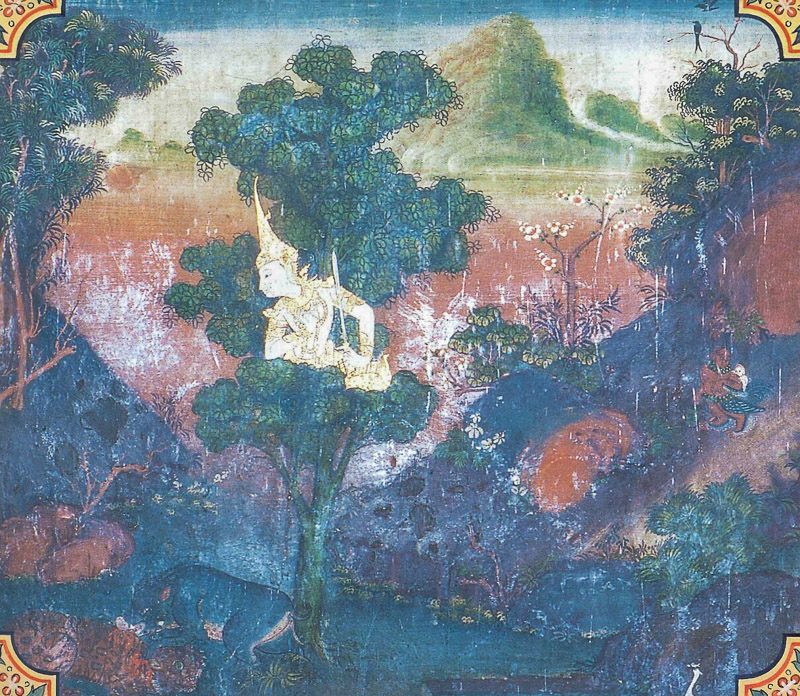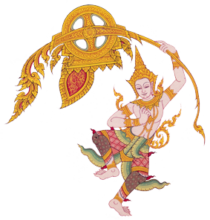
The Bodhisatta was once a tree fairy. A carpenter had rescued a young wild boar from a pit in the forest and took it home as a pet. The boar was exceptionally clever and well-mannered and helped the man at his work by fetching tools, holding measuring lines, and turning over logs. The carpenter loved the boar and feared that someone might kill and eat him, so he set him free.
While searching for a new home, the carpenter’s boar found a cave with lots of roots and fruits around it and asked if he could join the boars living there. They said he was welcome, but it was not as pleasant and safe a home as it appeared. Every morning, a tiger living on a nearby hill came and carried one of them off to eat. The carpenter’s boar said he could kill the tiger if they followed his orders, and they all agreed.
That night the carpenter’s boar taught them the art of war and chose the best location for their battle. He dug two pits and stood between them with all the other boars lined up behind him, the biggest and strongest boars standing around the small and young. When the tiger arrived, the boars did not run away as they usually did, instead they copied his actions: when the tiger glared, so did they; when he yawned, so did they; when he relieved himself, so did they. The boars had always run away or cowered in fear upon seeing him, so this morning the tiger retreated, unsure what to do when they stood bravely against him.
The tiger was friends with a false ascetic and always gave him a portion of his morning prey. When the false ascetic heard why he got no meat that day, he told the tiger there was no reason to fear boars; one roar and a leap would scare them for sure. So the tiger went back and the boars took up their positions again. When the tiger roared and leaped at the carpenter’s boar, he dove into one of the pits and the startled tiger stumbled and slid into the other. Then the carpenter’s boar jumped into the tiger’s pit, gored the tiger to death with his tusks, and tossed his body out. The other boars came and ate all the tiger’s flesh; those who did not get to eat any sniffed the others’ mouths hoping to get an idea of what tiger flesh tasted like.
The carpenter’s boar was full of pride from his victory, but he noticed the other boars remained uneasy. He asked what the problem was now, and the other boars told him about the false ascetic. They worried that he would just recruit more tigers. But the carpenter’s boar said killing a human was easier than killing a tiger and he marched everyone off to find the false ascetic. When he saw the boars approaching, the false ascetic ran and climbed up a giant fig tree. The carpenter’s boar ordered the women to bring water to the tree’s base, the children to dig away the mud, and the males to cut away at the roots. Then he charged at the tree to knock it over, and the false ascetic fell to the ground where other boars devoured him, leaving behind only bones.
Everyone was so grateful to the carpenter’s boar that they hoisted him up on the tree trunk and consecrated him king using water poured from the false ascetic’s skull. When it was all over, the Bodhisatta, who had watched everything happen, materialized and praised the boars for working together in unity.
In the Lifetime of the Buddha
The carpenter’s boar was an earlier birth of Dhanuggaha Tissa, one of the Buddha’s elder disciples. King Ajatasattu was a devoted supporter of Devadatta (the false ascetic was an earlier birth of him), a disciple of the Buddha who became his nemesis, and had taken the throne by following Devadatta’s advice to murder his father. The king’s mother died of grief after the assassination, and her brother, King Pasenadi, the righteous ruler of an adjacent realm and a devoted supporter of the Buddha, was full of hatred for King Ajatasattu. King Pasenadi wanted to take back a village that had been part of the dowry given with his sister when she married King Ajatasattu’s father, so he started a war.
King Pasenadi lost all the battles and was on the verge of being conquered. His advisors suggested getting advice from some of the Buddha’s wise disciples, so the king sent men to listen in on conversations at the monastery. Early one morning, some of these men were near Dhanuggaha Tissa’s leaf hut and they overheard him and another disciple discussing King Pasenadi’s pitiful war-planning skills: “That stupid, pot-bellied Pasenadi, who can’t even boil rice without spoiling it, knows nothing about the art of war.” He declared that King Ajatasattu could be defeated by posting two garrisons on two hills and acting weak, then attacking from the front and the rear when the king’s troops were between the hills. King Pasenadi followed this advice, and won the war.
When the Buddha heard some of his disciples discussing this matter, he told them this story so they knew that Dhanuggaha Tissa had also planned a successful war in the past.
